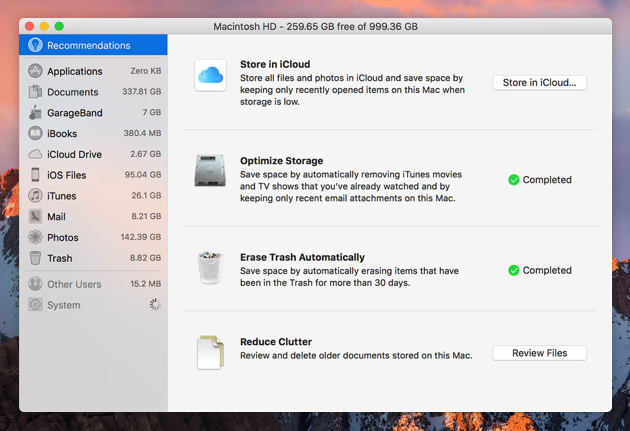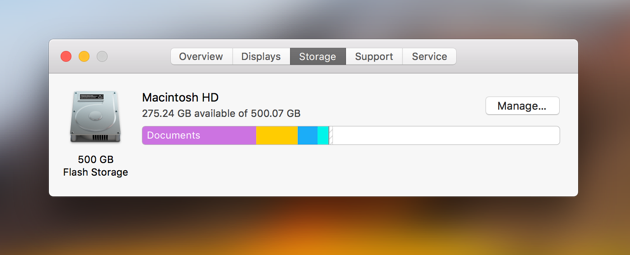Mac Os X View Drive Space
PC-300 USB Driver Version 1.3.0 Mac OS X This is a driver for using the PC-300 on MacOS X. Compatible with Apple's standards of CoreMIDI - Universal Binary (This driver can work on both CPU, Intel processors and PowerPC processors.). PC-300 USB Driver Version 1.4.0 Windows 98/ME. This is an Roland PC-300 driver for Microsoft Windows 98 / Microsoft Windows Me. Features: - Multiclient support - As many as four applications can simultaneously use each MIDI OUT/MIDI IN port. Simultaneously use four units. PC-300 USB Driver OMS for Mac Classic (OS 9) This is the driver necessary for connecting the PC-300 to a Macintosh running. PCR Driver Version 1.2.0 for Mac OS X This is a Universal Binary MacOS X driver for the PCR-30 / PCR-50 / PCR-80 / PCR-M1 / PCR-M30 / PCR-M50 / PCR-M80 / PCR-300 / PCR-500 / PCR-800 Compatible with Mac OS X v10.5 'Leopard' as of OCT. 26, 2007 PCR-300/-500/-800 Editor Version 2.0.0 for Windows XP. PC-300 USB Driver Version 1.3.0 Mac OS X. This is a driver for using the PC-300 on MacOS X. Compatible with Apple's standards of CoreMIDI. Universal Binary (This driver can work on both CPU, Intel processors and PowerPC processors.) - Single/Dual processor support. Roland pc-300 driver mac os x.

Mac Os X View Drive Space Windows 10

Jun 19, 2018 Your Mac’s hard drive probably has temporary files you don’t need. These files often take up disk space for no good reason. Mac OS X tries to automatically remove temporary files, but a dedicated application will likely find more files to clean up. Mar 03, 2016 Opening up 'About This Mac' is not the place to see what you have stored on your drive. Mimicking the iOS view (iPhone, iPad) is someone's idea of a sick twisted joke and should never be used as the way to look at how space is being used on a computer's drive. Looking at the Storage tab there.
Mac Os X View Drive Space Free
Mar 12, 2012 Mac OS X. FindSpace: View Disk Space Usage On Your Hard Drive In Tree View Mac by Fatima Wahab; Mar 12, 2012; No Comments; A while back, we covered two apps, DaisyDisk and Disk Scanner, the former worth $9.99 and the latter free. Both apps scan your hard disk and show you how your hard drive’s space is used in a daisy graph. Mar 02, 2005 From MacFixIt Mac OS X 10.3.8 Special Report: Disappearing hard drive space For some users, an issue is more prevalent under Mac OS X 10.3.8 where available space on the startup volume rapidly declines autonomously. In many cases, this issue. By default, Mac OS X does not display any icon on the desktop. Not even the internal hard disk. In this article, I will be showing how simply you can display Hard Disks on the Mac OS X desktop. As you can see, not a single icon is displayed on the Mac OS X desktop. To display hard disks icons on the desktop, follow the below steps. Find and Remove Large Files. To find particularly large files on your Mac’s hard disk, the quickest way is to use Finder: Open a new Finder window; In the search field just enter a space asterisk this will ensure that all items are included; Click on the little + icon located just below the search field; Change filter #1 to File Size.Click on the drop-down menu and choose Other. If you've been using a previous file system, it will be automatically updated when you upgrade to Mac OS Mojave. Files On-Demand settings are unique to each device, so make sure you turn it on for each device where you want to use it. To learn how an admin can turn on Files On-Demand, see Configure Files On-Demand for Mac (IT administrators).
NTFS drives are generally reformatted with exFAT, to access it on the macOS and Windows. Paragon NTFS driver supports Mac operating systems such as macOS Mojave, macOS High Sierra, macOS Sierra, Mac OS X EI Captain, Mac OS X Yosemite. Previously on MAC OS X, you could have enabled write permission by simply adding below lines to /etc/fstab LABEL=DRIVENAME none ntfs rw,auto,nobrowse After editing it, if you browse to /Volumes, you would able to see the NTFS drive which allows read/write operations. But on Yosemite. Ntfs driver mac os yosemite. Ntfs for yosemite free download - Paragon NTFS for Mac, Tuxera NTFS, Apple Mac OS X Yosemite, and many more programs.
Mac Os X View Drive Space Mac
| ||||||||||||||||||